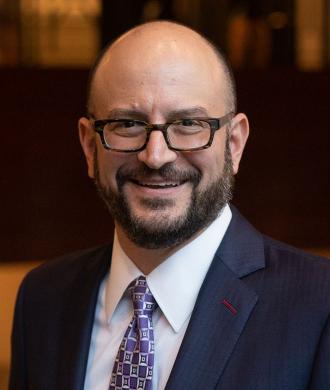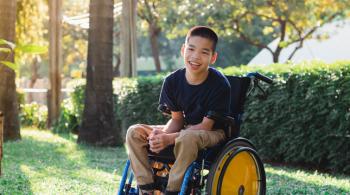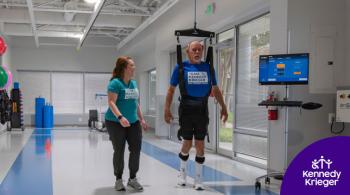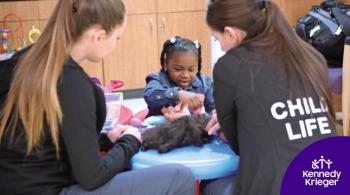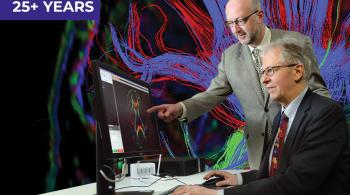This month marks five years since much of the United States was under a state of emergency due to the infectious disease, COVID-19 and the virus that causes it, SARS-CoV-2. Thankfully, primarily due to vastly improved immunity resulting from vaccines and natural immunity, the mortality of COVID-19 has dropped significantly. But one of the most challenging consequences of the infection is the condition we refer to now as long COVID, a disabling legacy of the pandemic, and the focus of this month’s episode of Your Child’s Brain---especially as it relates to children. Listen to Dr. Brad Schlaggar and his guest, Dr. Laura Malone as they discuss what we have learned in the past five years and what is on the future for treating children with this condition.
Resources
Learn More About Kennedy Krieger Faculty & Staff Members Featured in This Episode
Learn More About Kennedy Krieger Faculty & Staff Members Featured in This Episode
View Episode Transcription
Dr. Brad Schlaggar (BS): Welcome to Your Child's Brain, a podcast series produced by Kennedy Krieger Institute with assistance from WYPR. I'm Dr. Brad Schlaggar, Pediatric Neurologist, and President and CEO of Kennedy Krieger Institute. This month marks five years since here in Maryland, in early March of 2020, our governor, recognizing the threat of pandemic, declared a state of emergency and catastrophic health emergency due to the infectious disease, COVID-19 and the virus that causes it, SARS-CoV-2. The following week on March 13, 2020, the president declared a national emergency recognizing the global spread of COVID-19 and the World Health Organization's March 11, 2020 announcement that COVID-19 had reached pandemic status. At the peak of mortality in early 2021, the US was seeing over 25,000 deaths per week due to COVID-19 and roughly 1.1 million deaths over the first three years of the pandemic. Thankfully, primarily due to vastly improved immunity, resulting from vaccines and natural immunity, the mortality of COVID-19 has dropped precipitously. In 2024, for example, the US saw 47,000 deaths, an order of magnitude fewer than the 460,000 lost lives in 2021. In the first month of 2025, we saw roughly 3,000 deaths due to COVID-19 nationally for the CDC. Mortality, of course, is the most significant outcome to track, but one of the most vexing consequences of infection with SARS-CoV-2, seemingly regardless of the severity of illness from it is the condition we refer to now as long COVID, a disabling legacy of the pandemic, and the focus of this month's episode of Your Child's Brain, especially as it relates to children. We last discussed on this podcast long COVID in children on our August 2022 episode, about two-and-a-half years into the pandemic, and just prior to the start of the 2022/'23 school year. Our guest then, and today is Dr. Laura Malone, Director of the Pediatric Post COVID-19 Rehabilitation Clinic at Kennedy Krieger. She is also a physician scientist in Kennedy Krieger Center for Movement Studies, and is an Assistant Professor of Neurology and Physical Medicine and Rehabilitation at the Johns Hopkins University School of Medicine. Laura, a thought leader in pediatric long COVID, has been at the cutting edge, both clinically and scientifically. She, along with her team of colleagues at Kennedy Krieger, have focused over the past five years on treating children with long COVID, studying the disorder to find new and effective treatments, and disseminating their expertise to the broader community. Welcome back to the podcast, Laura. Let's start with the definition of long COVID and a review of the most common symptoms, especially in children.
Dr. Laura Malone (LM): Great, thanks for having me back. It's great to be here. When we talk about long COVID, actually, the definition has evolved and changed as we've learned different pieces of it over the last five years. Right now, the federal definition of long COVID is a chronic condition that occurs after SARS-CoV-2 infection, and it's present for at least three months after that infection. Now, the symptoms can be new after the COVID infection, they can wax and wane and alternate over time, or it can be a worsening of symptoms that maybe you had prior to the COVID infection. This has changed the time course of what we talk about of the symptoms. For a number of years, it was just four weeks that made the definition of long COVID, but now as research has evolved, really, we're looking at it as symptoms that persist for three months or more after your SARS-CoV-2 infection. You asked a little bit about some of the common symptoms, especially in children that we see. One of the most common symptoms that we see is actually fatigue. So kids just don't have their energy levels that they used to have. Children can also experience brain fog or cognitive attention difficulties and have a declining school performance as a result of that. They can experience pain or have dizziness or lightheadedness when they stand up. They can also have mood-related symptoms, some mental health sequela as well. We find that a lot of times children can have multiple symptoms after their SARS-CoV-2 infection, consistent with long COVID, or they could have just one. Really, some parents just say, "My child doesn't seem like the same child that they were before their infection." That's been pretty consistent from what we've heard over the past five years, but we're always hearing new complaints each time that we see kids in clinic.
BS: You mentioned the evolution of the definition and the clinical recognition. Could you take us back to those early days of the pandemic and how the recognition of long COVID emerged, first in adults, and then in children, as well as the establishment of the pediatric post COVID-19 clinic that you direct?
LM: In the early days of the pandemic, a lot was really unknown about the SARS-CoV-2, in particular, much less the long-term consequences of it. Very early in 2020, and even throughout 2021, a lot of the focus was on the acute infection of SARS-CoV-2. People were getting really sick, were getting hospitalized. They were ending up in intensive care units, trying to manage that acute phase of the infection. In children, most commonly, what we heard about is something called MISC, multi-system inflammatory syndrome of children, and that was a very severe infection that children would have. About a couple of weeks after their acute SARS-CoV-2 infection, that they would end up in the pediatric intensive care unit. They would require respiratory support. They were very sick requiring fluids and medications to support their blood pressure. That's what the focus was on very early on, but throughout 2020, in the summer and the fall, there started to be some reports about the long-term sequela. Surprisingly, actually, in some individuals that had relatively mild infections, they were managed at home. They weren't in the ICU. They weren't requiring respiratory support or those types of interventions, and that first came out in adult patients, that that awareness was starting to grow. Because of that long-term sequela at Kennedy Krieger, we have a longstanding history of multidisciplinary care and rehabilitation-based approaches to get people functioning back to where they were. The pediatric post-COVID clinic was established before we exactly knew what was going to happen in children, but we wanted to be prepared that if children had similar effects, whether from their hospitalizations or from mild infection, that we would be here to support that. Our clinic was established in the summer/fall of 2020, and we really started seeing our first patients in about the winter of 2020, and we've just grown and evolved in the last five years since then.
BS: Now we have a pretty significant denominator of experience. Broadly, how would you describe how children are impacted, perhaps differently than adults are by long COVID?
LM: Great question. I think that a lot of times, a lot of the information that we have about long COVID is very much focused on adult patients, the effects that it has on their work, the effects that it has on their daily living. A lot of the symptoms that we see are actually relatively common in children and adults, but children can have a much more difficult time describing what they're experiencing. A lot of the symptoms are relatively indolent or subtle. It may take some time to notice a pattern to really affect their functioning, and so I think it can go under the radar for a long period of time because the kids might have difficulty describing what they're experiencing or just find a way to manage and adapt themselves. Having symptoms for three months that may prevent you from going to school or participating in your extracurricular activities or socializing with your friends and family can really have a significant impact for children, so you can think about three months that's about for most kids, about a third of the school year that they might be experiencing these symptoms. I think that time course can feel a little more impactful for children than it does in adults. That's definitely something that we've seen that once kids sometimes get behind in school, that they have a hard time making it up because it's such a impressive amount of time that they're experiencing these symptoms.
BS: Could you share an example of maybe a patient that you see the story of that patient and how long COVID has interrupted or affected their lives?
LM: Sure. We've seen lots of patients where this has been the case. I think that a patient that we have seen and followed for a number of years is a high schooler that is very active, making good grades, might be an AP or advanced classes. Very athletic. They might be playing on a school soccer team or a school hockey team, and they get their COVID infection. Most commonly, it's relatively mild. They might have a runny nose or a fever for a day or two, and they'll have to be out of school for a couple days or so because of the infection. Then they try and go back to school, and they find they are having difficulty making it throughout the school day. They're so tired that after their first or second period, they are just completely wiped. They can't participate in their school activities. They have trouble concentrating on their homework, and so their grades may start to decline because they can't keep up with their school work, they can't concentrate. Things that came easy to them is no longer so easy to them. They are trying to find supports and do things to feel better. But everything that they try and do just doesn't seem to work. They rest a lot, but then they go out and do just hang out with their friends one afternoon, and then they're in bed for the next four days or so. These are pretty common stories that we hear and really have a significant impact on the quality of life of children, adolescents, and also their families, we find, as well.
BS: Let's talk about the numbers, the prevalence, like right now, what's the prevalence of lung COVID in children? Then the incidence rate. Interesting to hear what the incidence was at the beginning of the pandemic and how that may have evolved as well. Prevalence and incidence of long COVID in kids.
LM: Yeah, that's a great question. I'll preface it by saying we're still trying to refine these numbers a little bit because as I mentioned, I think that long COVID, especially in children, and especially younger children is probably underrecognized to a certain degree. Individual studies have reported wide ranges of what the prevalence is. But as time has gone on, I would say that the numbers are narrowing somewhere between 1-2% up to about 5-10% of children that have had long COVID or continue to experience long COVID. Now, interestingly, there is research that's done out of the CDC Center for Disease and Prevention that surveys individuals in the United States and they have looked at reported incidents and prevalence of long COVID, both in adults and children. They collected this data in 2022 around the time that we last spoke about this. What they found is that based on the survey, about 1-1.5% of children by their parents report had had long COVID. It was thought that maybe this was just something that was very acute in that, the first couple of years of the pandemic, we would see a lot of it, but then it would decrease over time. Actually, the data is out from the 2023 survey, and actually, we find that the prevalence rates are pretty similar. Even though we're having some kids that are getting better and their symptoms are resolving, we're finding that there's new cases that are still happening. I think that it still should be on the radar. It is still ongoing. Our rates have remained relatively stable over time.
BS: Factors like age, we've been talking about age, children, and adults, but also sex and other demographic factors. To what extent do they contribute to challenges in diagnosis of long COVID? For example, do these factors relate to the way long COVID presents clinically?
LM: We do know that in pediatric long COVID, that it tends to be more common in older school-age or adolescent age groups as opposed to younger children, zero to five years of age, for example. That could be for a number of reasons. There could be something in terms of the actual developmental process as to why older children might be more affected by it, or it could have to do with the way that we are able to diagnose long COVID and younger children just having difficulties being able to tell us the symptoms that they're experiencing. We also do know that sometimes the way that it presents can vary based on other demographic factors like you mentioned. Most of this research has been done in adults. But for example, one study had shown that if an adult patient is of black race, that they were more likely to have long COVID where they had symptoms of shortness of breath and something called a pulmonary embolism or a clot in their lungs. They might have diabetes. But they were less likely to have some of the symptoms of brain fog or cognitive difficulties. There might be some differences in how long COVID presents, not only based on the age but also based on other demographic factors like race and ethnicity.
BS: Let's talk about treatment approaches. So we've talked about children versus adults and clinical presentation and diagnostic rate. What about treatment? Are there differences in the way children and adults get treatment for long COVID?
LM: I think that generally our approaches tend to be pretty similar in children and adults. At our clinic at Kennedy Krieger at the post-COVID clinic, we use a multi-disciplinary rehabilitation-based approach, which is similar to how adult long COVID is managed as well. We use medications in addition to lifestyle treatments in order to try and improve functioning over time and mitigate symptoms that might be experienced by our patients. The one thing I will say with regards to the differences with adults and children right now is that when we think about more disease-specific or disease-modifying based treatments, there are ongoing clinical trials for adults with long COVID. Those are predominantly being implemented through the NIH recover efforts, whereby individuals are receiving treatments that hopefully help long COVID symptoms that might be more focused on the cause of long COVID or the pathogenesis. Right now, most of our treatments are borrowed from other disease processes. Hopefully soon, children will be eligible for clinical trials to look at some of these same disease modifying treatments. But that, I would say is sort of the major difference right now in the treatment approach for children versus adults.
BS: As I mentioned, it's been five years, that five year mark, and just as the diagnostic criteria have evolved, our knowledge about what may be causing the pathogenesis of long COVID, what might be causing it, hopefully has evolved as well. What have we learned, risk factors that individuals might have that increase the likelihood? Different organ systems of the body are involved? Does that give us information about what mechanisms might be at play? Then how does that all relate to potential more specific treatment approaches that are based on the mechanism rather than symptom management, as you're describing?
LM: With regards to risk factors for pediatric long COVID. There have been a number of studies that have looked at this question. Some risk factors that have been identified are, so individuals that were hospitalized or have a more severe acute infection have a greater risk of developing long COVID. That doesn't mean that if you have a mild acute infection that you can't develop long COVID from that, you definitely can, but it just increases your individual risk if you were hospitalized. Also, studies have shown that a lack of vaccination against COVID-19 increases your risk of long COVID. In addition to if people have other preexisting medical conditions, whether those are complicated medical conditions or they might be conditions like allergic conditions, if they have allergic rhinitis or asthma, those types of things. A body mass index of an elevated rate is seen as a risk factor for long COVID. Interestingly, there's also information about the actual variant of SARS-CoV-2 that can affect the individual risk of long COVID. We have seen. So as you know, SARS-CoV-2 has morphed over time, and we've had different variants. What we know is that the very early variance in that 2020/2021 time period, the individual risk of getting long COVID was higher for those variants. The individual risk from variants like Omicron and the variance that we're seeing now is a bit lower. But because Omicron and the more common variants now are much more common, more people have long COVID from Omicron than they do from those earlier variants. It's an interesting research to understand how the changes of the virus is affecting the long term sequela from it. Research is really focused on trying to understand that better and what might predispose somebody to having long COVID. One thing with regards to the pathogenesis of long COVID is a lot of research is ongoing to try and understand that because we think about long COVID as being a infection associated chronic condition. There might be other infection associated chronic conditions that we can learn about what causes them from our research in long COVID. There have been lots of theories and research studies out there. There seems to be some growing evidence of the fact that there's an immune dysregulation after the SARS-CoV-2 infection that then precipitates these long term symptoms. Other theories and there have been evidence for these in various research studies are the idea that there might be neuro inflammation or inflammation in other parts of the body. Ideas of maybe small clots throughout the body that are causing symptoms. In addition to alteration in the GI tract or gut tract, and this connection between the gut and the brain that might be causing the long term symptoms. I'm really eager to see where this research goes because I think there's a lot of information that we can gain from it.
BS: You're the author of a number of studies on long COVID, including one that was just published this past late summer/early fall in the journal Clinical Pediatrics, investigated the problem of orthostatic intolerance that develops in many pediatric, long COVID patients. Can you explain orthostatic intolerance, what that means? Then the study itself, along with what we learned as a consequence of it. What does it mean? What's the impact of that study for the medical community?
LM: First off, orthostatic intolerance is a condition whereby individuals when they go from a sort of lying down or supine position to an upright position, standing up, sitting up, experience worsening symptoms. Those are things commonly like dizziness or lightheadedness. They might feel like they need to pass out. They might experience brain fog or difficulty concentrating or thinking. They might have worsening fatigue, bracing heartbeats. All of this is a constellation of symptoms that they experience. It has to do with the transition from being supine to an upright posture. As you mentioned, we did publish a research article this past fall on orthostatic intolerance in our patients with long COVID. It's something that we always heard about a lot in the clinic. We really wanted to be able to capture what was the prevalence of orthostatic intolerance in our patients with long COVID. We actually found that it is incredibly common. About 70% of patients that we had seen in our clinic had a orthostatic condition as diagnosed on something called a passive standing tolerance test. This test is a great test because it can be done in any sort of clinical setting, requires a blood pressure cuff and a heart rate monitor. Basically, what you do is you have people lie down for five minutes, then stand up for five minutes, and you're recording symptoms, their heart rate and blood pressure throughout that. You can track how they're feeling in addition to what their vital signs are showing in order to diagnose some of these orthostatic conditions. I think being aware of it is really important for the medical community because it can really affect children's quality of life. We have some really good treatments, both lifestyle and medication based to help mitigate those symptoms and get kids back to the activities that they want to do.
BS: You're also the principal investigator on a good sized grant that's funded by the Agency for Healthcare Research Quality. That's one of the agencies within the Department of Health and Human Services. As part of that federal agency's long COVID care network. The grant, which sits at Kennedy Krieger is titled the Mid-Atlantic Pediatric Long COVID Network, implementing patient centered and multi disciplinary practices to improve pediatric long COVID. Now, of the 12 AHRQ grants funded, yours is the only one focused on pediatrics. Tell us about that Mid-Atlantic Pediatric Long COVID Network and what you hope to accomplish with this important federal funding.
LM: As you mentioned, through the grant, we're developing this pediatric long COVID network, so this group of providers that have some experience with long COVID across disciplines to be able to recognize and treat long COVID, hopefully in the medical home, in the communities where patients are so that they don't have to travel long distances in order to receive care. I think one of the most important things that this grant is focused on and the network as a whole is helping to increase recognition of long COVID so that patients can receive adequate treatment and support, rather than continuing to experience symptoms for a long period of time before they can connect with health care providers that are familiar with it and know how to manage it. As part of the grant, we're researching within our own clinic, how children and their families are experiencing long COVID, how they are interacting with schools, how they're interacting in their communities, in order that we can help sort of improve our care for them, for the whole person, the whole family. We're also working to educate community providers about long COVID. So we run a telementoring program whereby community providers can learn about long COVID and get more comfortable with diagnosing and managing it themselves.
BS: That last piece, that's this Project ECHO. That is this podcast episode will be released the first week of March. I believe that the first meeting of that Telementoring program through Project ECHO is also the first week of March. Talk more about what that is and how a provider who's interested could get involved with that.
LM: Like you mentioned, we will be launching our next spring series this March. We run our pediatric Long COVID ECHO series twice a year, in the spring and in the fall. What it is is it's a 10-week series where we meet on Zoom and we talk about various topics of long COVID. It is a bidirectional learning environment where community participants educate us about what they're seeing and how they manage long COVID, and we're sharing our experience over the past five years of what we've seen and how we recognize and work to treat long COVID. Now, we just recently got a paper accepted for publication on this project from our first year where we showed that we were actually significantly able to improve providers' confidence and knowledge based for long COVID through this series. We're really excited about the results of that. We have heard great feedback from providers that have participated in it. It's really directed towards pediatricians in the community, also mental health providers in the community, therapists, and also school nurses because schools are another place to help recognize and diagnose long COVID and get patients connected with resources. If people are interested, there's information on our website. If you want to join the program, we would love to have you, or feel free to reach out to us directly if you have any questions about it.
BS: We can include the link to that information, as well as links to other resources on the page associated with this episode. Thank you for that. Let's talk about, in wrapping now, the research that you and your colleagues or others in the emerging discipline around long COVID, including pediatric, long COVID. The research that's being done that is exciting, that you think is on the leading edge, that we should all be aware of that makes you optimistic about the future.
LM: There's so much research in this area, and both our team here at Kennedy Krieger and across the country and across the world are all embarking to try and understand more about long COVID because it can have such a significant impact on children and adults. Within our group, we are researching more of the mental health outcomes in addition to stigma that might be experienced by children with long COVID, something we hear a lot clinically, and there's not a whole lot of research on it, and so we're really trying to understand what is sort of the experience of individuals with long COVID and their families. We also are really trying to understand how children with neurodevelopmental disabilities might be experiencing long COVID. Are there particular types of presentations? Is it under recognized in that population? Because a lot of the research that we have on long COVID is in typically developing individuals. We know that the COVID-19 causes increased mortality in individuals with neurodevelopmental disabilities, and so we want to know a little bit more about what long COVID looks like in this population. We're really trying to understand the clinical experiences, the everyday experiences of our patient population, and how to deliver care better for them. We're also working on understanding some of these mechanisms that underlie common symptoms, things like fatigue. One of the collaborations that we have with another researcher at Kennedy Krieger, Dr. Vikram Chib, who studies fatigue and mechanisms of fatigue and why people choose to exert energy or not exert energy. We've collaborated, and we're looking at this brain behavioral mechanisms of fatigue in long COVID, and we're finding some really interesting, exciting results about that that will hopefully inform future treatments and understanding about the disease process.
BS: Well, that's an excellent place to end. Thank you to our guest, Dr. Laura Malone. We hope that you, our listeners, have found this discussion about long COVID in children and the new discoveries in battling this challenging disorder are both interesting and informative. Please check out our entire library of topics on Your Child's Brain at wypr.org, KennedyKrieger.org/ycb or wherever you get your podcasts. You've been listening to Your Child's Brain. Your Child's Brain is produced by Kennedy Krieger Institute with assistance from WYPR and producer Mark Gunnery. Please join us next time as we examine the mysteries of Your Child's Brain.

